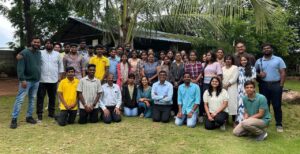Brittany Solano is a vice president at JDI, a marketing consultancy in Austin, TX that brings early-stage science and technology companies to market. She leads JDI’s future food practice and focuses her time on helping companies communicate how the tiniest things (cells, molecules, microbes) can have a big impact on how we eat.
How close are we to a future in which when we think of meat, we think of cell biology and tissue engineering instead of animals? Last week at MIT, 300 entrepreneurs, biologists, engineers, communicators, and students gathered for New Harvest 2019, to explore that question.
Although the term “cellular agriculture” was coined only four years ago (in a New Harvest community facebook group!), scientists have been working on culturing cells to make meat since 2001 when NASA scientists cultured goldfish cells to make a fish filet. And the idea of cultured meat was predicted by Winston Churchill in his oft-cited Fifty Years Hence speech.
Today, there are over 40 startups developing animal products without animals. Companies like Shiok Meats, New Age Meat, and Just have debuted their cell ag products to limited press audiences.
Investors are paying attention. So are larger meat, dairy and seafood groups. Unsurprisingly, consumers are starting to form opinions about this type of food long before they’ve gotten to try it themselves.
And yet the industry still has a long way to go. Costs are prohibitive and scale-up is a massive challenge. There are big scientific and technical challenges that still have to be overcome.
But as Perfect Day’s cell-based (and sold-out!) ice cream proves, we’re getting closer than we ever have to a world in which consumers can choose a product that is cellularly identical to their animal-based counterparts without the need for slaughter.
Here are 5 of the key insights about cell ag that surfaced from this year’s New Harvest event:
1 – Cell ag needs an Illumina moment
Illumina is largely credited with breaking Moore’s Law in genomics by introducing next-generation sequencing. It took $2.7 billion to sequence the first genome in the 1990s — now we can sequence a genome for under $1,000.
We need a similar moment in cellular ag to bring these products to scale — a scientific breakthrough that radically democratizes the technology.
The industry is identifying the various levers it can pull to drop the cost exponentially. David Bowman, CSO at Mission Barns, suggests four:
- Optimizing cell density – being able to grow cells more densely will help with exponential scaling
- Improving growth media – the media within which the cells grow and replicate must be optimized for each species of tissue being cultured. Today, much of the industry uses fetal bovine serum as a growth supplement. It’s effective, but it’s extremely expensive. It also comes from a cow fetus, which many in the cell ag industry take issue with given a primary goal of the industry is to reduce our dependence on livestock for food.
- Recycling growth – Being able to reuse growth media would cut down on waste and the costs of inputs.
We heard from companies hoping to serve the cell ag market and develop a supply chain around it, which was new this year. For example, Seafood Analytics provides measurements for quality assurance and safety. Heuros is developing a more affordable cell culture media. Culture Biosciences provides cloud-based automated bioreactors (though they don’t yet work with mammalian cells).
How will we know when the inflection point is imminent? You’ll start seeing companies care a lot more about unit economics. Today, that question is premature and highly speculative. But as companies get closer and closer to bringing their products to the consumer, they’ll have to wrestle with questions like: are we competing with commodity beef prices or the margins of plant-based meat? How does price play a role in consumer adoption?
2 – You’re going to start hearing more about fish and bugs
The conversation has evolved from the “holy grail” of a cell-based steak. Insects, fish, and crustaceans are increasing areas of focus for cell ag researchers – potentially because the science and path to market could prove much faster.
“Entomoculture” was a new category introduced at New Harvest and coined by New Harvest researcher Natalie Rubio. Insect cells are easier to culture than mammalian cells for a variety of reasons (for example, they can tolerate a broad range of environmental conditions and require less energy to culture) and could be a viable option for bringing cell-based meat to market more quickly.
For some, of course, there’s still the “ick” factor associated with a grasshopper steak, even without legs and antennae. But cricket protein bars are on the rise and groups like Little Herds are promoting the environmental and health benefits of eating insects. Entomoculture is certainly “out there,” but by the time a cell-based insect product comes to market, perhaps consumers more broadly will be ready.
Seafood was a big focus as well – we heard from companies like BlueNalu, Shiok Meat, and Finless Foods. Problems with overfishing, toxins and microplastics showing up in our seafood, as well as market volatility, certainly contribute to an interest in this area.
3 – The regulatory fight has already begun
Regulation is being taken seriously, as is consumer safety. Even though millions of venture dollars have poured into cell-based meat, there’s a general tone of caution when it comes to bringing these products to market. Companies like Memphis Meats and Finless Foods emphasized the need to collaborate with the USDA and FDA on regulatory guidelines as a means of creating public trust.
There are still big questions – about who will regulate fish (which wasn’t mentioned in the USDA and FDA’s joint memo about cellular agriculture) and how food safety inspections will be conducted – but the industry is generally taking a cooperative stance when it comes to regulatory oversight. The fight over the legal definition of meat, however, is already being debated between industry groups.
4 – Cellular agriculture has a talent gap
The crowd at New Harvest was refreshingly diverse. If the demographics in the room were any indication, women and people of color are well-represented in this field and there is a high rate of participation from international scientists and entrepreneurs. There was also an unprecedented number of students in attendance, demonstrating that New Harvest’s work to establish cellular agriculture as an academic discipline seems to be working.
Despite the diversity, hiring in this industry is hard. There just aren’t enough people working on the science. David Bowman, CSO of Mission Barns, recommended that anyone creating a career in this industry mentor two others to build up the talent that the industry will need to scale as the science grows.
Kate Krueger, research director at New Harvest, talked about addressing that talent gap by funding research fellows at universities across the globe. Academia is an important pipeline of talent and expertise, but because federal grants are mostly siloed for medical research, researchers are unable to get the funding they need to pursue agricultural applications of what is traditionally medical research.
The other hiring challenge lies in the fact that scientists currently account for 75% of today’s jobs in cell ag; yet Justin Kolbeck, CEO of Wild Type, projects that 70% of future jobs in the industry will be filled by non-scientists. The opportunities for professionals in HR, Legal, Marketing, Sales, and Business Development roles are heating up. The challenge is in creating a symbiotic culture that ensures the technology is developing towards market demand.
Hopefully, cellular agriculture’s present diversity is a reflection of its ability to bridge science and business and maintain a global, gender, and ethnic diversity as it grows.
5 – Good communication strategies are needed urgently
I heard from more than one participant that communicating with consumers doesn’t matter yet since we’re not yet selling anything on the market. But it’s clear that people are already forming their own opinions and, in the absence of a standard language, even defining the terms of the discussion.
Undoubtedly, cell ag companies need to staff up on communicators, policy experts, and community builders with urgency.
But Dr. Garrett Broad in his talk about “Engaging with Critiques of Cellular Agriculture” emphasized that it’s more than just a PR strategy that’s needed. It’s an inclusive process for listening to the concerns of all stakeholders. Otherwise, he says, the industry may make money, but it won’t deliver on the transformation of our food system that these new companies are promising.
As with any new technology, the key to adoption will be in starting now to build bridges with stakeholders, especially with those who already disagree.




